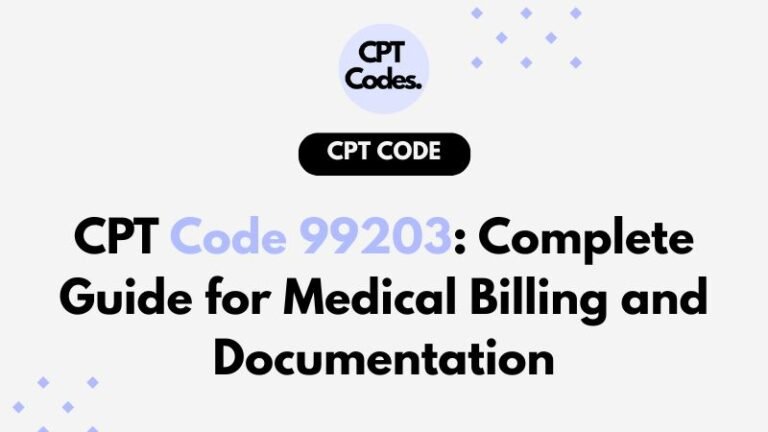CPT code 99203 is one of the most frequently used Evaluation and Management (E/M) codes in outpatient medical billing. It identifies an office or other outpatient visit for a new patient that requires a medically appropriate history and/or examination and low level of medical decision-making.
Understanding CPT 99203 is essential for physicians, medical coders, and billing professionals because accurate coding ensures proper reimbursement, compliance with payer requirements, and minimizes claim denials.
Code Description
CPT 99203 is officially defined by the American Medical Association (AMA) as:
“Office or other outpatient visit for the evaluation and management of a new patient, which requires a medically appropriate history and/or examination and low level of medical decision making. When using time for code selection, 30–44 minutes of total time is spent on the date of the encounter.”
In simple terms, 99203 applies when a new patient is seen, and the physician provides a comprehensive assessment but not as complex as higher-level E/M codes like 99204 or 99205.
Category & Code Type
- Category: Evaluation and Management (E/M)
- Code Type: New Patient Office or Outpatient Visit
- CPT Code Range: 99202–99205 (New Patient Visits)
- Associated Place of Service (POS): Typically POS 11 (Office), POS 22 (Outpatient Hospital), or POS 19 (Off-campus Outpatient Hospital)
Coding Criteria for 99203
To report CPT 99203, the encounter must meet one of two criteria: time-based or medical decision-making (MDM) based.
1. Time-Based Coding
- Total time: 30–44 minutes
- Includes all face-to-face and non-face-to-face time spent by the provider on the same date (e.g., reviewing records, documenting, ordering tests).
2. Medical Decision-Making (MDM)
- Level: Low complexity
- Number of problems: 2 or more self-limited or minor problems, or one stable chronic illness, or one acute uncomplicated illness/injury.
- Amount/complexity of data: May involve limited data review (labs, imaging).
- Risk: Low risk of morbidity from testing or treatment.
Billing Guidelines
1. New Patient Requirement
CPT 99203 can only be billed for new patients, meaning the provider or another provider in the same specialty and group practice has not seen the patient within the past three years.
2. Payer Considerations
- Always check payer-specific rules for documentation and time tracking.
- Medicare and commercial insurers may audit documentation for MDM accuracy.
- Some payers prefer MDM over time-based selection unless clearly supported by documentation.
3. Modifier Use
- Modifier 25: Use when a significant, separately identifiable E/M service is performed on the same day as another procedure.
- Modifier 24: For unrelated E/M services during a postoperative period.
4. Telehealth
99203 can also be billed for telehealth visits when all MDM and documentation requirements are met, using modifier 95 and an appropriate telehealth POS code.
Documentation Tips for CPT 99203
- Clearly identify the reason for visit and chief complaint.
- Include a medically appropriate history and exam.
- Document all tests ordered, reviewed, or interpreted.
- Support the MDM level with detailed clinical reasoning.
- Record total time spent if time-based coding is used.
- Ensure signatures and credentials are complete.
Accurate and complete documentation prevents denials, downcoding, and payer audits.
Common Examples of Use
- Primary Care Visit: A new patient with stable hypertension and mild hyperlipidemia requiring medication adjustment.
- Dermatology Visit: New patient with a rash diagnosed as contact dermatitis.
- Orthopedic Visit: New patient with a mild ankle sprain requiring conservative treatment.
- Pediatrics: New child with acute otitis media, treated with antibiotics.
Each example involves low medical complexity and appropriate documentation.
Common Mistakes & Denials
- Upcoding or downcoding: Selecting 99204 or 99202 incorrectly.
- Insufficient documentation: Missing MDM details or time justification.
- Using 99203 for established patients: This code applies only to new patients.
- Omitting modifiers: Forgetting modifier 25 for same-day procedures.
- Incomplete time tracking: Failing to record total time spent.
Key Takeaways
- CPT 99203 = New patient, low complexity E/M visit.
- Choose based on time (30–44 minutes) or low-level MDM.
- Document thoroughly to support billing.
- Use correct modifiers and POS codes.
- Avoid coding errors that lead to denials or audits.
Frequently Asked Questions (FAQ)
1. What is the difference between CPT 99203 and 99213?
- 99203 is for new patients, while 99213 is for established patients.
- The complexity level (low) is similar, but new patient codes require more documentation.
2. Can I bill 99203 for telehealth visits?
Yes, if the visit meets all MDM or time-based requirements. Use modifier 95 and a telehealth POS code.
3. How much time is required for 99203?
A total of 30–44 minutes of provider time on the date of service.
4. What documentation supports 99203?
A medically appropriate history, exam, and low-level MDM or total time documentation.
5. Can nurse practitioners and physician assistants bill 99203?
Yes, as long as they meet all scope-of-practice and payer documentation requirements.
6. What are common payer denials for 99203?
Typical denials occur due to insufficient MDM justification, duplicate billing, or incorrect patient type (new vs. established).
Final Note:
Accurate use of CPT 99203 improves billing compliance, supports fair reimbursement, and ensures that clinical documentation aligns with AMA and payer requirements. Regularly reviewing E/M coding updates helps maintain compliance and avoid costly errors.
Sources and References
-
American Medical Association (AMA). CPT® Evaluation and Management Codes.
https://www.ama-assn.org/practice-management/cpt -
Centers for Medicare & Medicaid Services (CMS). Evaluation and Management Services.
https://www.cms.gov/medicare/payment/coding/evaluation-and-management-services -
AAPC. E/M Coding Guidelines and Code Descriptions.
https://www.aapc.com/resources/medical-coding/em-coding-guidelines/ -
CMS Medicare Learning Network (MLN). Evaluation and Management Services Guide.
https://www.cms.gov/outreach-and-education/medicare-learning-network-mln/mlnproducts/evaluation-and-management-services-guide

